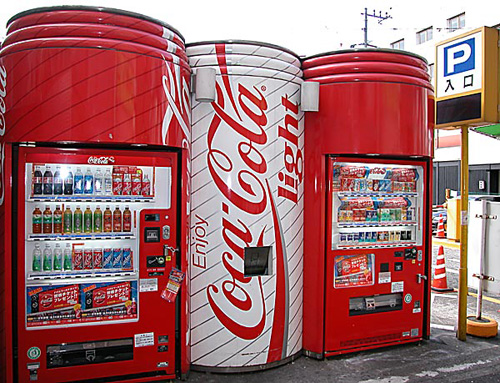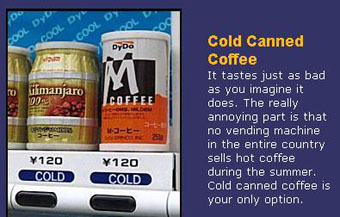This Webpage Title
Japan - Vending Machines


| About the Country |
|---|
Thirsty in Tokyo? Never fear, you are only a few metres away from one of the country's 20,000,000 vending machines. Thats one machine for every 6 people in Japan! Jidoohanbaiki - Japanese vending machines
In even the tiniest of Japanese towns, large unprotected, metal boxes can be found near train stations, near shops, service stations or just by the side of the road. It's almost a religion!

Talk about vending machines in Australia and the “Coke Machine” springs to mind.
Alternatively, cigarette or coffee machines and ticket machines are considered. Japan brings a whole new edge to dispensing goods through a box.

These vending machines are known as ‘jidoohanbaiki' and are found singly or in clustered groups everywhere throughout the country.
Instantly recognisable and eminently practical, these machines compliment stores and stalls with almost an equal variety of items.

The history of Japanese vending machines
The real surge in interest in jidoohanbaiki began during the Tokyo Olympics in 1964 with the need to supply large numbers of people with a number of goods and a severe lack of space and staff. Over the years since then, the variety of goods sold has increased dramatically as has the number of vending machines which is currently well over 6 million machines.
What can you buy?
As well as the typical soft drinks, you can buy health drinks, yoghurt drinks, milk, hot and cold coffee, chocolate or tea and even alcoholic drinks such as sake, beer and whiskey.

Within each of these categories of drinks is a huge variety with new brands and options becoming available every year. For example, “can coffee” can come hot or cold, in different brands and in different types like Café au Lait, black coffee, sweet coffee, bitter coffee or mocha. There is an option to suit everyone!
While the range of drinks available is huge and accounts for around half the machines in Japan, everything from foodstuffs to literature to entertainment to clothing and gifts can be bought from a jidoohanbaiki.
The food might be as simple as instant ramen (hot and ready to eat!) or lollies, or as complex as a whole meal.
The literature might be manga-comic books for all ages, paperbacks or newspapers. For entertainment try videos and CDs.

Clothing is hats, shirts and even underwear!
Gifts are fresh flowers or real pearls?

Using the machines
While the machines all take coins, most also accept common notes and give change. Some even accept 10000 yen notes, the highest currency. And of course, if you do need change, there is a machine that can do that, too.
With the low crime rate in Japan, few machines are vandalised or robbed.
What is becoming more difficult is to keep the machines stocked and serviced and the demand for staff to do this continues to grow.
Technology may help out with computerised monitoring of purchases already in place and trials for ordering depleted stock using data directly from the machine so that servicemen can carry sufficient of the appropriate items.

Why are they so popular?
Due to the lack of space in Japan and the high cost of shop floors, or perhaps due to their 24 hour availability, vending machines provide an invaluable service.
There is no need to queue and, particularly with items such as contraceptives and sanitary items, there is no need to confront a human face, rather you can be anonymous to the machine.

The sheer convenience of knowing where your favourite items are and that they are accessible at any time and most locations, makes this form of buying ideal for the busy Japanese.
As Japan moves into the 21st century, the variety and efficiency of these jidoohanbaiki continues to grow and, while furniture and other larger items are not yet available through automatic dispensers, who knows what the future will hold!
